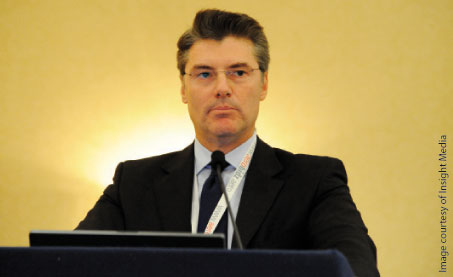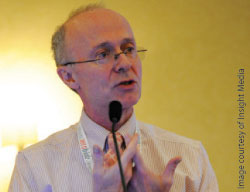
Dr Yiannis Paraschis, President, ACI EUROPE and CEO, Athens International Airport: “Airports are long-term, defensive investments. We know that despite the slowdown and decline there will be long-term growth.”
The conference attracted a range of stakeholders – including airport CEOs, CFOs, airport operators, airlines, investors and regulators – and provided an engaging forum for discussion of the key industry issues presented by the global economic downturn.
ACI EUROPE’s 2008 traffic figures, released shortly prior to the conference, provided a sense of context. Overall, passenger numbers declined 0.2%, with around an 8% decrease in November and December. Four out of five airports registered declining traffic. Olivier Jankovec, ACI EUROPE Director General, said “What is even more worrying is the pace at which freight traffic, the barometer for international trade, has gone down – much faster and much deeper than passenger traffic. In December, freight traffic was down by nearly 22%. This reflects a 14% gap between freight and passenger traffic, suggesting that there is more pain to come. Make no mistake, 2009 will be an annus horribilis traffic-wise.”
It was a view echoed by ACI WORLD Director General Angela Gittens; she outlined figures showing that in December nine of the top 10 international airports reported traffic declines – Dubai being the only exception with a 5% increase. “We see a contraction in 2009 as inevitable with an estimate of a 4% decrease in passenger traffic, comprised of an acceleration of the downturn in the first quarter of 2009 and a slow stabilisation of traffic during the rest of the year. We forecast that 2010 will show spotty growth, with 2011 starting a rebound,” said Gittens.
Both Jankovec and Gittens sent strong messages that the current economic situation must not be an impediment to the expansion and development of airport infrastructure. While surviving current challenges, airports must also plan for the future based on medium to long-term growth requirements. Furthermore, as engines of economic growth, airports must be incentivised to invest for the benefit of passengers and of local communities.
“Notwithstanding the current situation, European air traffic is forecast to double by 2030; EUROCONTROL’s recently-published Challenges of Growth study highlights that, by 2030, 11-25% of passenger demand will not be accommodated due to lack of airport capacity” said Jankovec, calling for a clearer policy direction at EU level on the reconciliation of aviation growth with environmental protection. “We do accept our own responsibilities in earning our licence to grow – but planning processes must be streamlined and the airport capacity crunch needs to move up to the top of the EU’s transport agenda,” he added.
Gittens described it as “a fundamental conundrum for airports as enterprises with high fixed costs and a long-term outlook that have to make major capital investments even while operating in an economic downturn”.
James Cherry, President ACI WORLD and CEO, Aéroports de Montréal, was unequivocal: “Even with the current economic uncertainty, airports must take a long-term view and plan for future growth. Airports should press ahead with infrastructure plans.”
Challenges and opportunities
While the present situation is challenging, many speakers emphasised the opportunities that exist. Chris Tarry, Aviation Industry Research and Advisory, CTAIRA, stressed that “the demand for air travel will recover although the industry will emerge from the downturn in a different size and shape”. “The winners will have cash and coherent and credible plans that are capable of implementation,” he said. Following Mr Tarry, Laurie Price, Director of Aviation Strategy at MottMacDonald, also spoke optimistically about the industry’s potential recovery.
Dr Yiannis Paraschis, President, ACI EUROPE and CEO, Athens International Airport, explained that with the right business model, the right people and support from government, airports are attractive businesses. “Airports are long-term, defensive investments. We know that despite the slowdown and decline there will be long-term growth,” he said. “It is clear that all industry stakeholders will need to play their part and this crisis is certainly a unique opportunity to look for commonalities.”
While there is a liquidity squeeze and ultra-conservatism being prescribed by lenders, Justin Symonds, MD, Head of Transport Logistics, ABN AMRO, outlined that credit ratings reflect the attractive, long-term characteristics of public airport assets.
Regulation
The regulatory environment was also explored in some detail – a vital issue given the weakening revenues of airports, coupled with the increasing market power of the consolidated airlines. Declan Collier, CEO, Dublin Airport Authority, argued for a balanced approach to regulation. “Over-regulation can lead to stagnation; good regulation incentivises investment. We’d argue that regulation should be for the passenger,” he said. “Airports and airlines must work together to develop both airport capacity and airline viability. The current priority for all is economic recovery.”
The need for airports and airlines, as business partners, to work together was reiterated by Jeff Poole, Director, Industry Charges, Fuel & Taxation, IATA. He said “From our perspective we see a real opportunity – we have a unity of problem and a unity of solution. The big picture is effective competition and working together within a consistent, agreed framework. We are in this together; we are one industry.”

Harry Bush, Group Director, Economic Regulation, UK CAA: “We need to think about natural limits to regulation. Key design issues are the role of government versus the independent regulator – defining their respective roles, the costs of government intervention and ensuring a stable framework for investment.”
Harry Bush, Group Director, Economic Regulation, UK CAA, echoed Collier’s assertion that regulation should put the passenger first. Bush presented a fitting perspective on changing UK regulation – Manchester Airport has been de-designated for price control and the Competition Commission has recommended the break-up of BAA, with London-Gatwick currently up for sale. “We need to think about natural limits to regulation. Key design issues are the role of government versus the independent regulator – defining their respective roles, the costs of government intervention and ensuring a stable framework for investment,” he said.
While the scale and duration of the economic downturn remains unclear, the consensus across the two-day conference was that the industry has survived previous economic crises and that the long-term forecast for traffic growth remains positive. There is no one-size-fits-all formula to recovery and airports must react and make decisions based on their specific situation. Crucially, the message was that airports must continue to work with airlines and other industry stakeholders to ensure they are prepared for the resurgence when it comes.







